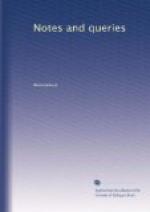hand-writing in other papers, and saw it was
one and the same. Soon after, Mr. Arundell favoured
me with some further information on the subject, which
I here give, as it adds still more to the interest
of the story:—’Looking into
Gilbert’s
History of Cornwall, in the
parish of South Petherwin, there is said to be
in the old mansion of Botathan five portraits
of the Bligh family; one of them is the likeness
of the boy, whose intimacy with the ghost of Dorothy
Durant has been spoken of in his first volume,
where she is erroneously called Dingley.
If this be a fact, it is very interesting; for
it is strange that both Mr. Ruddell, the narrator
(whose manuscript I lent to Gilbert), and De Foe,
should have called her Dingley. I have no
doubt it was a fictitious name, for I never heard
of it Launceston or the neighbourhood; whereas Durant
is the name of an ancient Cornish family:
and I remember a tall, respectable man of that
name in Launceston, who died at a very advanced
age; very probably a connexion of the Ghost Lady.
He must have been born about 1730. Durant
was probably too respectable a name to be published,
and hence the fictitious one.’ Mr. Arundell
likewise says, ’In Launceston Church is
a monument to Charles Bligh and Judith his wife,
who died, one in 1716, and the other in 1717.
He is said to have been sixty years old, and was
probably the brother of Samuel, the hero of Dorothy
Dingley. Sarah, the wife of the Rev. John
Ruddell, died in 1667. Mr. Ruddell was Vicar of
Aternon in 1684. He was the minister of Launceston
in 1665, when he saw the ghost who haunted the
boy.’”
Such is Mrs. Bray’s account of these very curious
circumstances. The ghost story inserted in Gilbert,
as mentioned above, is altogether so much in the style
of De Foe, that a doubt remains whether, after all,
he may not have been the author of it. Can “D.S.,”
or any of your readers, throw further light on the
subject?
D.S.Y.
[Footnote 1: Of
Landulph, Cornwall, the author of Discoveries in
Asia Minor, and
the well-known Visit to the Seven Churches of
Asia. Mr. Arundell
is now dead.]
* * * *
*
PET-NAMES.
“Mary” is informed that “Polly”
is one of those “hypocorisms,” or pet-names,
in which our language abounds. Most are mere abbreviations,
as Will, Nat, Pat, Bell, &c., taken usually from the
beginning, sometimes from the end of the name.
The ending y or ie is often added, as
a more endearing form: as Annie, Willy, Amy, Charlie,
&c. Many have letter-changes, most of which imitate
the pronunciation of infants. L is lisped for
r. A central consonant is doubled. O
between m and l is more easily sounded
than a. An infant forms p with its
lips sooner than m; papa before mamma.
The order of change is: Mary, Maly, Mally, Molly,
Polly. Let me illustrate this; l for r




